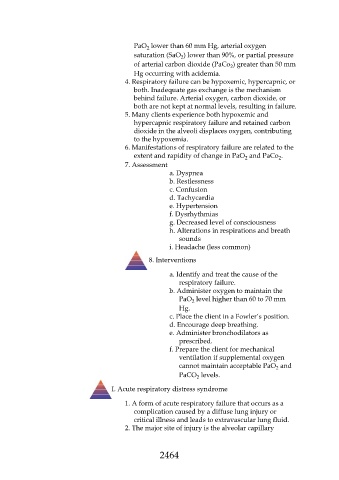Page 2464 - Saunders Comprehensive Review For NCLEX-RN
P. 2464
PaO lower than 60 mm Hg, arterial oxygen
2
saturation (SaO ) lower than 90%, or partial pressure
2
of arterial carbon dioxide (PaCo ) greater than 50 mm
2
Hg occurring with acidemia.
4. Respiratory failure can be hypoxemic, hypercapnic, or
both. Inadequate gas exchange is the mechanism
behind failure. Arterial oxygen, carbon dioxide, or
both are not kept at normal levels, resulting in failure.
5. Many clients experience both hypoxemic and
hypercapnic respiratory failure and retained carbon
dioxide in the alveoli displaces oxygen, contributing
to the hypoxemia.
6. Manifestations of respiratory failure are related to the
extent and rapidity of change in PaO and PaCo .
2
2
7. Assessment
a. Dyspnea
b. Restlessness
c. Confusion
d. Tachycardia
e. Hypertension
f. Dysrhythmias
g. Decreased level of consciousness
h. Alterations in respirations and breath
sounds
i. Headache (less common)
8. Interventions
a. Identify and treat the cause of the
respiratory failure.
b. Administer oxygen to maintain the
PaO level higher than 60 to 70 mm
2
Hg.
c. Place the client in a Fowler’s position.
d. Encourage deep breathing.
e. Administer bronchodilators as
prescribed.
f. Prepare the client for mechanical
ventilation if supplemental oxygen
cannot maintain acceptable PaO and
2
PaCO levels.
2
I. Acute respiratory distress syndrome
1. A form of acute respiratory failure that occurs as a
complication caused by a diffuse lung injury or
critical illness and leads to extravascular lung fluid.
2. The major site of injury is the alveolar capillary
2464

